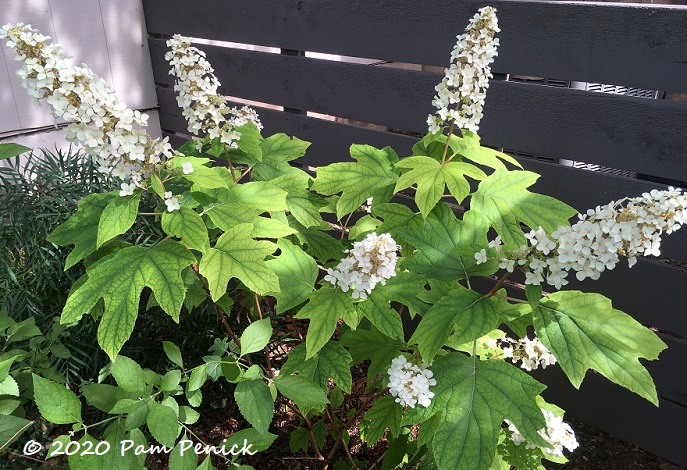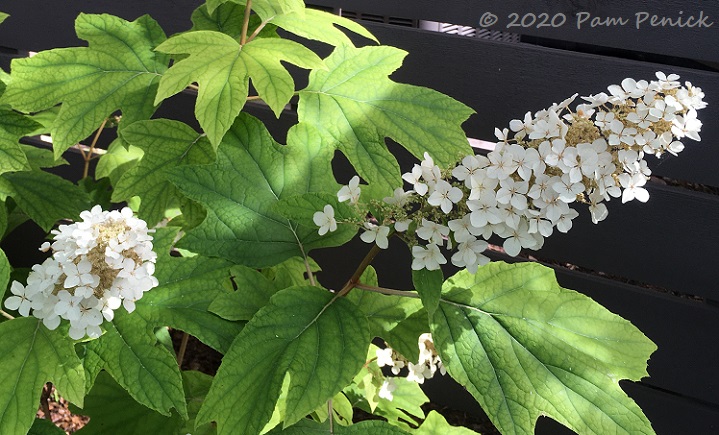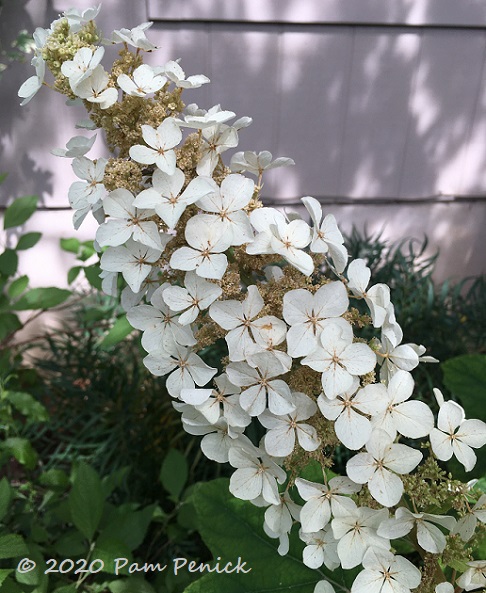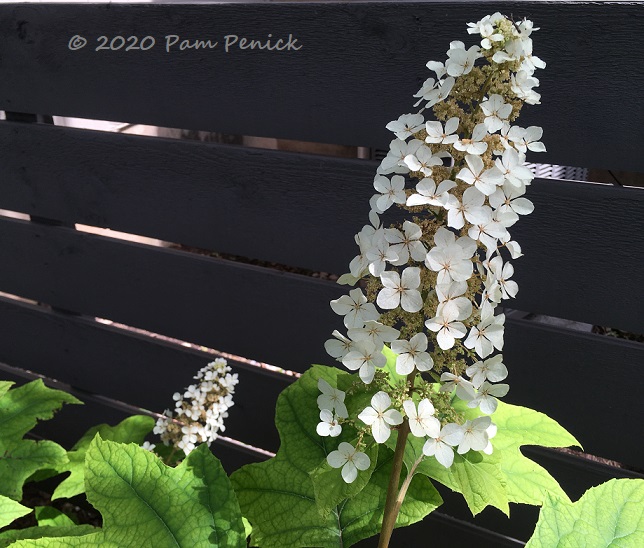Oakleaf hydrangea blooming but wants acidic soil

After years of coveting oakleaf hydrangeas (Hydrangea quercifolia) I’d seen in other Austin gardens, I found a shady, relatively moist spot to plant one of my own. Near an air-conditioning unit’s condensate discharge, which directs water toward this bed, and shaded by a large crape myrtle, this white-flowering, deciduous shrub has grown quickly and bloomed beautifully the past two springs.

But this year it shows signs of chlorosis — yellowing leaves with dark-green veins — caused by iron deficiency in alkaline soil. I’ve never had my soil tested, but I can guarantee it’s alkaline because of all the limestone in the ground here in Austin. Like azaleas, camellias, and other Southern garden classics, hydrangeas prefer acidic soil, which is found throughout the Southeast but not so much in Texas, except maybe the East Texas pineywoods.

Oakleaf hydrangea can tolerate more alkalinity than other hydrangeas, so it’s pretty much the only variety that grows here in Central Texas. The French mophead (Hydrangea macrophylla) found throughout the South, whose flowers turn blue or pink depending on acidity level, doesn’t thrive here at all. But in richer, deeper soils around town, you’ll see oakleaf hydrangea, just as you’ll see Southern magnolia eking out an existence here at the western edge of its range.

I knew this before planting my oakleaf hydrangea. It’s partly why I resisted planting one for so long — that and its need for regular watering. But those beautiful white flower clusters and big, lush leaves seduced me. I’ve already sprinkled pellets of soil acidifier around it, as well as around some loropetalums that are also showing signs of chlorosis. I hope that’ll be enough to keep them happy because I won’t take extreme measures to grow a plant that would rather be growing someplace else.
How about you? Are you growing oakleaf hydrangea or any other acid-loving plant in Texas, and what has your experience been?
__________________________
Digging Deeper
Come learn about gardening and design at Garden Spark! I organize in-person talks by inspiring designers, landscape architects, authors, and gardeners a few times a year in Austin. These are limited-attendance events that sell out quickly, so join the Garden Spark email list to be notified in advance; simply click this link and ask to be added. Season 8 kicks off in fall 2024. Stay tuned for more info!
All material © 2025 by Pam Penick for Digging. Unauthorized reproduction prohibited.


My Oak Leaf looks similar. I thought it was getting too much sun. I didn’t realize it was the acidity of the soil. Thanks for the information. Maybe that is why it has never bloomed.
Lack of acidity, but yes, probably.
Maybe this will make you feel better.- ‘m in east Texas, and I planted three oakleaf hydrangeas purchased at the Stephen F. Austin State University plant sale. I planted them in the shade and babied them. They were planted about 4-6 feet apart. Of the three, one thrived, one died, and one ekes out a meager existence with just one puny branch. The one that thrived is lovely and huge. I treated all three in the same manner. Nematodes? Some weird soil disease? Genetics? I’m clueless. Even in east Texas there are no guarantees. Also, now that I’m in east Texas, I find I miss many of the plants that will only grow in alkaline conditions.
Hah, I’ve had the same thing happen, not with oakleaf hydrangea but with other plants. I never know why either. It does tend to make one even more grateful for the survivor though!
As for plants that thrive in alkaline soil — our many lovely native Central Texas plants — I love them too and would miss them if I ever left this region.
I planted 2 under a loquat in a shady area in the fall. Two weeks ago my neighbor took out a large tree and now I have all day sun over my mostly shade garden. I’m trying to view it as a new opportunity, but the saddest part for me is that one of hydrangeas is now in too much sun and I don’t have another good spot for it. I’m shading it as best I can for now, but still not sure what I’m going to do with it. I wasn’t aware of the acidity issue with it, so I will kept that in mind going forward.
I’m sorry, Margo. That’s the worst, when a neighbor (or Mother Nature) suddenly changes the conditions in your garden. There’s no time for plants to acclimate, and all you can do is plan a new planting scheme for the new reality. Maybe a gardening friend with a shady spot can rescue your hydrangea for you, although it’s getting to the hot time of year, which makes transplanting shrubs more challenging. All I can tell you is that you’ll probably soon come to love your new sunny garden, as I’m learning to appreciate the flowering plants I can grow in my back garden since we lost a beloved tree a year and a half ago.
I’m a sucker for magnolias – I just LOVE the fragrance. I grew Little Gem at a previous Austin house, which seemed to work ok (although they probably wanted more sun), and am trying again in Dripping Springs. I know I’m pushing it, but I’ve had a couple of those heavenly blossoms already this spring, and hope they keep coming. Like you, I won’t go to extremes, but tried to find the best spot for them on the property. Good luck with the hydrangeas…they are beautiful even with a bit of chlorosis!
Magnolia flowers are beautiful, as are the shiny-on-top, velvet-brown-on-the-bottom leaves. If you love them, go for it! That’s always reason enough to try any plant (aside from invasives, of course).
I planted two dwarf Oakleaf Hydrangeas last fall. I’ve had good luck with a couple of Rhodies for 15 years, so I should be OK. Here they bloom in the autumn. They are planted with Martagon lilies and Maidenhair ferns in a bed that actually gets afternoon sun. I will start paying attention to the leaf color though they are so new to me that it may take a while to determine what they should look like!
Just goes to show how vastly different gardening conditions are in Wisconsin vs. Texas, and also how adaptable oakleaf hydrangea is that it can grow in both states. It blooms in autumn there and appreciates afternoon sun — wow!
I thought I’d share this here. Sheryl Williams, a master gardener and friend of mine here in Austin, wrote this on my FB post:
Mine is planted in front of the porch in my thick clay soil and does not display chlorosis. Part of the reason is that it is heavily composted and mulched. Here’s my two cents: you’ve planted yours where it gets water, which means that the limestone is in constant solution, thus making the area extra alkaline. I suggest you double down on compost and scratch in coffee grounds. You might also consider foliar feedings of chelated iron (although it’s getting too hot – run out on those days that the high doesn’t get over 80) or seaweed. It will always be an uphill battle given the geology of your yard, but those bloom spikes might make it worth the extra effort. As a substitute you might consider a mock orange (Philadelphus texensis or P. ernestii) The spike isn’t as spectacular but the white blooms are just magical in shady spots. I’ve had fantastic luck with mine in very xeric locations.
To combat chlorosis on my oakleaf hydrangea (I’m in east Austin), I use Fertilome chelated liquid iron — a recommendation from an employee of Shoal Creek Nursery. It can be applied to the soil or the foliage. It does the trick & is worth it!
Forgot to add: I usually only need to use the Fertilome chelated liquid iron once a year in the spring. Totally worth it!
OK, that sounds easy enough! I’ll get some this week. Thanks for the tip!
Very interesting! I saw beautiful oakleaf h blooming in the parking lot at Austin CC. I’m from Chicago where we grow Annabelle to great success. So I planted three oakleaf last fall in the shade (thinking one would live as is my norm here in TX!). Well they are all alive but no blooms and actually sort of darker leaves with some brown spots and brownish red patches. I live out in Bee Cave Any thoughts?
Oh gosh, I have no idea, Leslie. I hope your plants recover!
I planted one near the property line of our yard south of Tyler, Texas. We have very little sun here, so shade gardening is the only way to go. My oakleaf hydrandgea is about 8 feet tall and beautiful, but all the branches and blooms lean towards my neighbor’s house where they have more sun! Despite the frustrations of gardening in a forest, I know I’m going to miss these tall trees when I move to our new house on the Edwards Plateau.
In your East Texas region, can’t you also grow azaleas quite easily? If so, it sounds like you have acidic soil, which the hydrangea obviously loves. And how exciting for you to be able to discover a whole new plant palette when you move to the Edwards Plateau!
Yes, we have azaleas all over the property— all over Tyler, actually. The “Azalea Trail” is an annual event here. I’m looking forward to trying a lot of new plants when we move to the hill country. I’ve been putting your “Plant This” articles on my desk top. Many thanks!
That’s great to hear. Happy planting!
A neighbor in Travis Heights successfully planted the French macrophylla hydrangea. Of course, sall of our lots loped toward the creek on its way to the river and we all had beautiful deep rich dirt without rock, alluvial!. Point being that always check your soil with the test kits readily available at many nurseries because you never know. Also, other friends have a tester they got on Amazon that they like and it does not require mixing or much more than poking the metal tester into the dirt. They are attempting blueberries! I say, Ha!, like to see it happen but really? The nieghbor with the hydrangeas had a fantastic green thumb. He had scrumptious ranunculus as well. He had been renting out his parents house that he grew up in but moved back at this own retirement and renovated it. His was a labor of love that we all enjoyed. PS: the only azaleas in the area were in a tall raised planter built on Travis Hts Blvd.
I knew as I was writing this post that I would hear from Austinites successfully growing acid-loving plants – ha! In fact, just a half mile from my house, which is west of MoPac and in the caliche hills, there’s a neighbor growing dogwoods! I admire them every spring when they bloom. So yes, you are absolutely right that a soil test can reveal unexpected opportunities. It’s also true that many gardeners are much less lazy than I, and are willing to take extra measures to grow plants that require soil amendments, lots of composting, coffee grounds, etc. (see Sheryl’s comment I posted from FB, above), and that can make all the difference too. Gardening is about experimentation, after all, and it never hurts to try! 🙂
I love Oak Leaf Hydrangeas too! I planted my first one a month or so ago in an area of the yard that gets dappled shade. My recently planted blue hostas are there as well and are doing fine. I didn’t know about OLH’s love of acidity, though. Hmmm. A neighbor has two humongous ones in her front yard in full sun! I know! And they look very happy. I do know that staring expectantly at my hydrangeas won’t make them bloom but I am hopeful to see these gorgeous white blooms soon.
I hope it blooms great for you, Susie. Seems a good sign that your neighbor has happy ones in her yard.
Seriusly, do the coffee grounds thing. It will help acidify your soil and repel pests too. If you don’t drink coffee, Starbucks and some other coffee places will donate their used grounds. It’s also good in compost if you get too much! I live in Connecticut and have 4 gorgeous oakleaf Ruby Slippers hydrangeas. My problem is the deer nibbling on them… but they don’t do too much, actually are pretty good pruners. All best, Helen
See, now the hunting down of coffee grounds is what I mean by having to take extreme measures. 🙂 If we generated coffee grounds at home, it would be easy enough. But I know myself all too well to know I’m not going to drive around to Starbucks asking for used grounds on a regular basis. 😉 This plant is just gonna have to hang on or make way for something else.
treat it with espoma iron tone